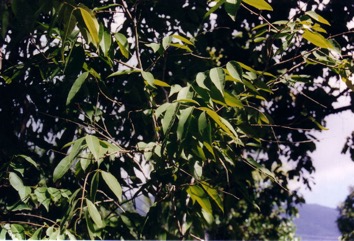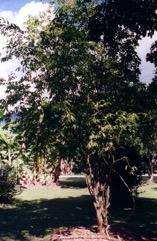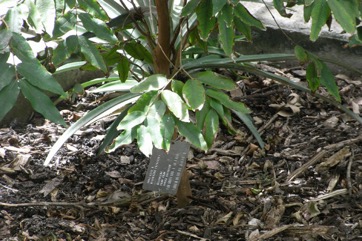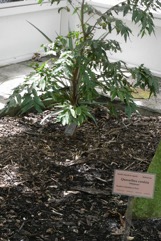Camu camu, Rumberry

A tropical plant. It grows in the Amazon rainforest in swampy areas. The lower section can often be submerged in water. It grows best in hot, wet, tropical climates. It can be grown in the subtropics and can stand temperatures down to freezing. It needs plenty of moisture and can stand flooding. Trees can almost become totally flooded and still fruit. It normally grows in regions with 1,500-4,000 mm rain per year. The temperatures are about 25°C. It needs a minimum average temperature above 20°C.
Also known as:
Araca de praia, Araza de agua, Cacari, Camocamo, Camu-camzeiro, Doubtful jaboticaba, Guayabito, Guayabo, Guayabito
Synonyms
- Eugenia divaricata Benth.
- Eugenia grandiglandulosa Kiaersk.
- Myrciaria caurensis Steyerm.
- Myrciaria divaricata (Benth.) O. Berg.
- Myrciaria lanceolata O. Berg.
- Myrciaria obscura O. Berg.
- Myrciaria paraensis O. Berg
- Myrciaria phillyraeoides O. Berg.
- Myrciaria riedeliana O. Berg.
- Myrciaria spruceana O. Berg.
- Psidium dubium Kunth
- Marliera macedoi D. Legrand [Invalid]
Edible Portion
- Fruit
Where does Camu camu grow?
Found in: Amazon, Andes, Asia, Australia, Bolivia, Brazil, Colombia, Ecuador, Guyana, Pacific, Peru, Philippines, SE Asia, South America, Venezuela
Notes: These are one of the highest recorded Vit C plants known. It has 100 times the Vit C of orange. In is rich in anti-oxidants.
Status: A valuable fruit. It is sold in local markets.
Growing Camu camu, Rumberry
Cultivation: Plants are grown from seed. The pulp is washed off the seeds and they are sown fresh.
Edible Uses: The fruit are occasionally eaten fresh. More commonly they are used to flavour drinks, ice-creams and sweets. They need sweetening with sugar.
Production: Seedlings can take 4-5 years to begin producing fruit. A mature tree can produce 15 kg of fruit. It can be irregular fruiting.
Nutrition Info
per 100g edible portion| Edible Part | Energy (kcal) | Protein (g) | Iron (mg) | Vitamin A (ug) | Vitamin c (mg) | Zinc (mg) | % Water |
|---|---|---|---|---|---|---|---|
| Fruit | - | - | - | - | 1,350 | - | 89.9 |
| Fruit | 26 | 0.4 | 0.5 | - | 2,195 | 0.5 | 92 |
Camu camu, Rumberry Photos




References
Brazil: Biodiversity for Food and Nutrition. http://www.b4fn.org/countries/brazil/
Coronel, R.E., 1982, Fruit Collections in the Philippines. IBPGR Newsletter p 10 (As Myrciaria paraensis)
Daly, D. C., An Index of Common Names of Plants in Acre, Brazil. New York Botanical Garden Universidade Federal do Acre.
Facciola, S., 1998, Cornucopia 2: a Source Book of Edible Plants. Kampong Publications, p 158 (As Myrciaria paraensis)
Fieldiana, Bot. 29:501. 1963
Flores, P. S., 1997, Cultivo de Frutales Nativos Amazónicos. Tratado de Cooperación Amazónica. Secretaría pro – tempore. Lima– Perú
Fouqué, A., 1972, Espèces fruitières d'Amérique tropicale. Institut français de recherches fruitierès outre-mer
Grandtner, M. M. & Chevrette, J., 2013, Dictionary of Trees, Volume 2: South America: Nomenclature, Taxonomy and Ecology. Academic Press p 436
Hermandez Bermejo, J.E., and Leon, J. (Eds.), 1994, Neglected Crops. 1492 from a different perspective. FAO Plant Production and Protection Series No 26. FAO, Rome. p16
Hunter, D., et al, 2019, The potential of neglected and underutilized species for improving diets and nutrition. Planta (2019) 250:709-729
Kermath, B. M., et al, 2014, Food Plants in the Americas: A survey of the domesticated, cultivated and wild plants used for Human food in North, Central and South America and the Caribbean. On line draft. p 560
Lorenzi, H., Bacher, L., Lacerda, M. & Sartori, S., 2006, Brazilian Fruits & Cultivated Exotics. Sao Paulo, Instituto Plantarum de Estuados da Flora Ltda. p 221
Lyle, S., 2006, Discovering fruit and nuts. Land Links. p 295
Morton, Julia F., 1987, Fruits of Warm Climates. Creative Resources Systems, Inc. . p. 389
New World fruits Database (As Myrciaria caurensis)
NYBG herbarium "edible"
Paz, F. S., et al, 2021, Edible Fruit Plant Species in the Amazon Forest Rely Mostly on Bees and Beetles as Pollinators. Journal of Economic Entomology, XX(XX), 2021, 1–13
Rodrigues, R. B. et al, 2001, An Amazonian fruit with a high potential as a natural source of Vitamin C: the camu-camu (Myrciaria dubia). Fruits, Vol 56, p. 345-354
Rufino, M. M., et al, 2009, Quality for fresh consumption and processing of some non-traditional tropical fruits from Brazil. Fruits, Vol. 64, p 361-370
Rufino, M. M. et al, 2010, Bioactive compounds and antioxidant capacities of 18 non-traditional tropical fruit from Brazil. Food Chemistry 121: 996-1002
Smith, N., et al, 2007, Amazon River Fruits. Flavors for Conservation. Missouri Botanical Gardens Press. p 200
Tankard, G., 1990, Tropical fruit. An Australian Guide to Growing and using exotic fruit. Viking p 106 (As Myrciaria paraensis)
USDA, ARS, National Genetic Resources Program. Germplasm Resources Information Network - (GRIN). [Online Database] National Germplasm Resources Laboratory, Beltsville, Maryland. Available: www.ars-grin.gov/cgi-bin/npgs/html/econ.pl (10 April 2000)
Vael, L., 2015, Ethnobotanical study of the plant use in the natural landscape of two mestizo communities in the Ucayali region of the Peruvian Amazon. Universiteit Gent.
Vasquez, R. and Gentry, A. H., 1989, Use and Misuse of Forest-harvested Fruits in the Iquitos Area. Conservation Biology 3(4): 350f
Villachica, H., (Ed.), 1996, Frutales Y hortalizas promisorios de la Amazonia. FAO, Lima. p 77
World Checklist of Useful Plant Species 2020. Royal Botanic Gardens, Kew
www.colecionandofrutas.org